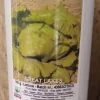Hot Cayenne Pepper | 25g
₦2,400.00 Original price was: ₦2,400.00.₦2,100.00Current price is: ₦2,100.00.
30 people are viewing this product right now
🔥 6 items sold in last 3 hours
Hot Cayenne Pepper has a thin wall and is vivid red when it is fresh and dried. Fruit-bearing seeds have a fruity flavor that is spicy and sweet. Grow this variety of pepper to boost your output.
We offer national shipping. Visit us today to shop!
Buy more save more!
Buy from 5 to ∞ items and get 5% OFF
on each productHot Cayenne Pepper, the fiery red fruit, is a member of the nightshade family, closely related to bell peppers and jalapeños. Its intense heat, ranging from 30,000 to 50,000 Scoville Heat Units (SHU), comes from capsaicin, the compound that gives chili peppers their characteristic spiciness. But beyond its fiery reputation, cayenne pepper holds a wealth of potential health benefits, making it a valuable addition to both your culinary creations and your wellness routine.
We offer shipping across state lines. Visit us to shop right away!
Features of Hot Cayenne Pepper
Latin Name: Capsicum annuum
Light: The entire sun
24 inches tall
The Cycle of Life: Annual Hybrid Open-pollinated status
The hue: red
Requirements for Production
Light: A cayenne pepper plant needs at least eight hours of direct sunlight each day to develop at its best.
Soil: Cayenne pepper plants need fertile, well-drained soil that is neutral in pH, wet, and well-drained. Peppers that are hotter than usual may be produced by soil that is more acidic. If you’re unsure, it could be worthwhile to test the pH of the soil.
Watering cayenne pepper plants correctly might be tricky. They do need moist soil, but too much watering can sometimes be detrimental. The plant’s foliage may turn yellow if the soil gets too dry or too wet. Generally speaking, it’s best to give the plant a deep watering at the base every few days. The plant’s surroundings can benefit from mulching in order to retain moisture.
Temperature and Humidity: The cayenne pepper plant is a tropical warm-weather species that needs continuously warm temperatures to survive. These plants are unable to endure temperature extremes, whether they are hot or cold. Consistently low temperatures, below 55 degrees Fahrenheit, will cause leaf discoloration and inhibit growth. The plants will be harmed or killed by temperatures below 32 degrees Fahrenheit, and overnight temperatures above 75 degrees Fahrenheit can affect the number of peppers produced.
Fertilizer: Rich, fertile soil is necessary for the growth of cayenne peppers. If your soil isn’t exceptionally rich and you plan to fertilize your plants, watch out for fertilizers heavy in nitrogen. This will focus energy on dazzling foliar growth instead of fruit production.
Diseases and growth problems of Hot Cayenne Pepper
exclusively use drip irrigation, plant exclusively in well-drained soils, reduce soil compaction, and use a 4-year crop rotation to prevent bacterial spots and Phytophthora.
An inadequate vegetation cover contributes to sunscald.
With appropriate soil calcium and regular moisture, prevent blossom end rot.
An overabundance of nitrogen, hot or cold weather extremes during the flowering cycle, tarnished plant insect injury, and selection of late, poorly adapted types can all result in large, bushy plants with few peppers.
Frequently Asked Questions (FAQs) About Hot Cayenne Peppers
What is a cayenne pepper?
Hot cayenne pepper is a fiery red fruit belonging to the nightshade family, closely related to bell peppers and jalapeños.
How hot are cayenne peppers?
Cayenne peppers range from 30,000 to 50,000 Scoville Heat Units (SHU), making them quite spicy.
What are the health benefits of cayenne pepper?
Cayenne pepper may offer various potential health benefits, but more research is needed.
Can I grow my own cayenne peppers?
Yes! Cayenne pepper plants are relatively easy to grow with proper care.
How much sunlight do cayenne pepper plants need?
Cayenne pepper plants need at least eight hours of direct sunlight daily.
What kind of soil is best for cayenne peppers?
Cayenne peppers prefer fertile, well-drained soil with neutral pH and consistent moisture.
How often should I water cayenne pepper plants?
Water deeply at the base every few days, allowing the soil to dry slightly between waterings.
What temperature is ideal for cayenne pepper plants?
Cayenne peppers are warm-weather plants and thrive in consistently warm temperatures. They cannot tolerate frost or extreme heat.
What kind of fertilizer is best for cayenne peppers?
Cayenne peppers do well in rich soil. Avoid fertilizers high in nitrogen, which can hinder fruit production.
How can I prevent diseases in my cayenne pepper plants?
Use drip irrigation, well-drained soil, crop rotation, and proper watering to prevent bacterial spots and Phytophthora.
Only logged in customers who have purchased this product may leave a review.
Related products
₦4,100.00


₦3,000.00










Reviews
There are no reviews yet.